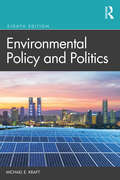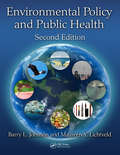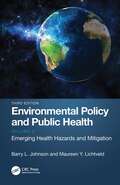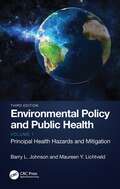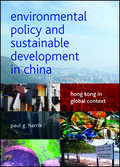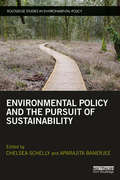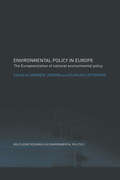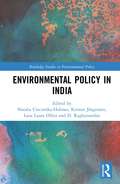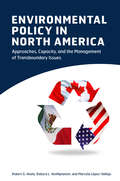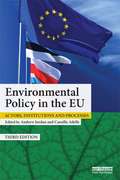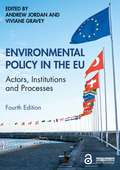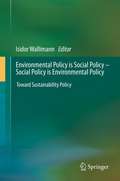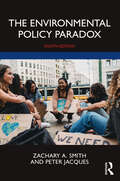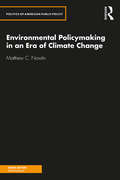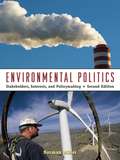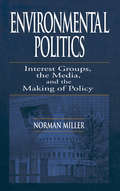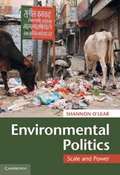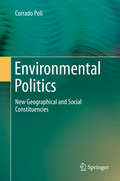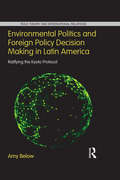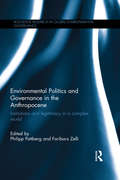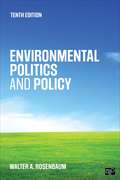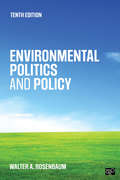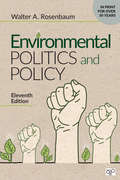- Table View
- List View
Environmental Policy and Politics
by Michael E. KraftFor more than twenty years, Environmental Policy and Politics has kept instructors and students abreast of the challenges presented by contemporary environmental, energy, and natural resource problems in the United States. Now in its eighth edition, Michael E. Kraft has updated his definitive text to capture the changing nature of environmental problems as well as policy proposals made through 2020. Drawing from work within environmental science, policy analysis, and political science, this text continues to help readers think critically about how best to address problems through a variety of public policy tools and strategies at all levels of government. Important updates to this new edition include: • The latest information about environmental challenges and governmental responses to them, with extensive citation of key sources and websites. • Key political and policy decisions through late 2020, including presidential appointments, budgetary decisions, major legislative initiatives, and congressional actions. • New learning objectives to facilitate student understanding of key concepts and their applications, arguments advanced over environmental challenges and policies, and the goals and methods of environmental policy analysis. • Coverage of new topics that have emerged during the Trump presidency, including the Clean Power Plan repeal and reduction of environmental regulation, climate change, land conservation, changes in natural resources policies, and a comparison of the Republican and Democratic positions on climate change in 2020. • Updated summaries of scientific studies, government reports, and policy analyses. • Revised discussion questions and new suggested readings. Environmental Policy and Politics is an essential resource for upper level undergraduate and graduate students in political science and environmental studies looking for an accessible, well-researched, and up-to-date text, written with style and flair.
Environmental Policy and Public Health
by Barry L. Johnson Maureen Y. LichtveldAs with the first edition, this second edition describes how environmental health policies are developed, the statutes and other policies that have evolved to address public health concerns associated with specific environmental hazards, and the public health foundations of the policies. It lays out policies for what is considered the major environmental physical hazards to human health. Specifically, the authors describe hazards from air, water, food, hazardous substances, and wastes. To this list the authors have added the additional concerns from climate change, tobacco products, genetically-modified organisms, environment-related diseases, energy production, biodiversity and species endangerment, and the built environment. And as with the first edition, histories of policymaking for specific environmental hazards are portrayed. This edition differs from its antecedent in three significant themes. Global perspectives are added to chapters that describe specific environmental hazards, e.g., air pollution policies in China and India. Also there is the material on the consequences of environmental hazards on both human and ecosystem health. Additionally readers are provided with information about interventions that policymakers and individuals can consider in mitigating or preventing specific environmental hazards.
Environmental Policy and Public Health: Emerging Health Hazards and Mitigation, Volume 2
by Barry L. Johnson Maureen Y. LichtveldWritten by environmental health experts with long teaching and professional careers in policy and public health, the third edition of Environmental Policy and Public Health comprises two volumes, addressing key physical hazards in the environment that impact public health. The first volume on Principal Health Hazards and Mitigation is complemented by the second volume, Emerging Health Hazards and Mitigation. Volume 2 discusses emerging health hazards and mitigation including environment-related infectious diseases, COVID-19 pandemic, social justice, and drugs and public health. New in this volume are a chapter on firearms violence as a public health hazard, a chapter on transportation and how built environments can affect human health and social well-being, and a chapter on noise and light pollution. As human populations increase and technology adds more devices to daily use that generate noise and light, adverse human and ecological health effects have become recognizable and require time-sensitive policy actions to mitigate and where possible prevent adverse health effects. Each chapter explains with great clarity how new environmental health issues are translated into public health policies. The volume concludes with case studies and practice questions to facilitate interactive learning for upper-level undergraduate and graduate students taking courses in public health and environmental sciences. The case studies and practice questions allow for a diverse portfolio of in-person and hybrid pedagogical strategies and tools at the fingertips of faculty who not only teach policy courses but whose course topics have policy relevance, such as climate and health.
Environmental Policy and Public Health: Principal Health Hazards and Mitigation, Volume 1
by Barry L. Johnson Maureen Y. LichtveldWritten by environmental health experts with long teaching and professional careers in policy and public health, the third edition of Environmental Policy and Public Health comprises two volumes addressing key physical hazards in the environment that impact public health. The first volume on Principal Health Hazards and Mitigation is complemented by the second volume, Emerging Health Hazards and Mitigation. The health of the environment is inextricably linked to that of people. Thoroughly updated, Volume 1 describes how the quality of air, water, and food is threatened by the presence of toxic substances and explains why climate change is a global health priority already impacting human health and the environment. The mitigations discussed in this volume are twofold: policies that are intended for control of specific hazards and suggested hazard interventions. The role of policy in addressing each of these key environmental health areas is extensively discussed in this volume as well. Each chapter explains step by step how new environmental health issues are translated into public health policies and concludes with practice questions to facilitate interactive learning for upper-level undergraduate and graduate students taking courses in public health and environmental sciences. The step-by step approach, as well as the case studies and practice questions, allow for a diverse portfolio of in-person and hybrid pedagogical strategies and tools at the fingertips of faculty who not only teach policy courses, but whose course topics, such as climate and health, have policy relevance.
Environmental policy and sustainable development in China: Hong Kong in Global Context
by Paul G. HarrisDrawing on practices and theories of sustainability, Environmental policy and sustainable development in China explores the prospects for achieving environmentally benign economic and social development in China and beyond. Using the Chinese 'world city' of Hong Kong as a backdrop and case study, it introduces major conceptions of sustainability, describes historical and political contexts for environmental policymaking, and analyses key challenges related to sustainable development, including air pollution, water quality, waste, transport and climate change. The book will be a valuable and unique resource for students, teachers and readers interested in environmental policy, sustainable development and ecological governance, especially in China and Hong Kong. All of the author's royalties from sales of this book will be donated by Policy Press to Friends of the Earth (Hong Kong) and WWF (Hong Kong).
Environmental Policy and the Pursuit of Sustainability (Routledge Studies in Environmental Policy)
by Chelsea Schelly Aparajita BanerjeeIt is increasingly apparent that human activities are not suitable for sustaining a healthy global environment. From energy development to resource extraction to use of land and water, humans are having a devastating effect on the earth’s ability to sustain human societies and quality lives. Many approaches to changing the negative environmental consequences of human activities focus on one of two options, emphasizing either technological fixes or individual behavior change to reduce environmental harms through sustainable consumption habits. This book takes a different approach, focusing on the role of environmental policy in shaping the possibilities for and creating hindrances to pursuing more sustainable use of environmental resources. This unique compilation examines environmental policy through empirical case studies, demonstrating through each particular example how environmental policies are formed, how they operate, what they do in terms of shaping behaviors and future trajectories, and how they intersect with other social dynamics such as politics, power, social norms, and social organization. By providing case studies from both the United States and Mexico, this book provides a cross-national perspective on current environmental policies and their role in creating and limiting sustainable human futures. Organized around four key parts – Water; Land; Health and Wellbeing; and Resilience – and with a central theme of environmental justice and equity, this book will be of great interest to students and scholars of environmental policy and sustainability.
Environmental Policy in Europe: The Europeanization of National Environmental Policy (Environmental Politics #Vol. 7)
by Duncan Liefferink Andrew JordanThe continuing development of the European Union (EU) is transforming policy and politics in its member countries, and possibly in an even larger number of potential members. This book offers a detailed investigation of the Europeanization of national environmental policy in ten western European countries since 1970.By blending state-of-the-art theories with fresh empirical material on the many manifestations of Europeanization, it sheds new light on the dynamics that are decisively reshaping national environmental policy. It also offers an original assessment of how far Europeanization has produced greater policy convergence in western Europe.Throughout, the approach taken is genuinely comparative, drawing on the insights provided by leading country specialists.
Environmental Policy in India (Routledge Studies in Environmental Policy)
by Natalia Ciecierska-Holmes Kirsten Jörgensen Lana Laura Ollier D. RaghunandanThis book systematically introduces historical trajectories and dynamics of environmental policy and governance in India. Following the features of environmental policy in India as outlined in Chapter 1, subsequent chapters explore domestic and international factors that shape environmental policy in the country. The chapters examine the interplay between governmental and non-governmental actors, and the influence of social mobilisation and institutions on environmental policy and governance. Analysing various policy trajectories, the chapters identify and explore five central environmental policy subsystems: forests, water, climate, energy and city development. The authors drill down into the social, economic, political and ecological dimensions of each system, shedding light on why striking a balance between national economic growth and environmental sustainability is so challenging. Drawing on political science theories of policy processes and related theoretical concepts, this innovative edited volume will be of great interest to students and scholars of environmental policy and politics and South Asian studies more broadly.
Environmental Policy in North America: Approaches, Capacity, And The Management Of Transboundary Issues
by Robert G. Healy Debora L. VanNijnatten Marcela López-VallejoThis comprehensive analysis of key issues in North American environmental policy provides an overview of how the US, Mexico, and Canada differ in their environmental management approaches and capacity levels, and how these differences play into cross-border cooperation on environmental problems. The book offers insights into transboundary cooperation both before and after NAFTA, and presents a framework for making environmental interaction more effective in the future. The book is organized into two parts. The first, more general, section compares the national contexts for environmental management in each country—including economic conditions, sociocultural dynamics, and political decision-making frameworks— and shows how these have led to variations in policy approaches and levels of capacity. The authors argue that effective environmental governance in North America depends on the ability of transboundary institutions to address and mediate these differences. The book's second section illustrates this argument, using four case studies of environmental management in North America: biodiversity and protected areas, air pollution (smog); greenhouse gas reduction, and genetically modified crops.
Environmental Policy in the EU: Actors, institutions and processes
by Andrew Jordan Camilla AdelleThe European Union (EU) has a hugely important effect on the way in which environmental policies are framed and implemented in many different parts of the world, but especially Europe. The new and comprehensively revised edition of this well-known textbook provides a state-of-the-art analysis of all the EU’s environmental policies. Comprising five parts, it covers the rapidly changing context in which EU environmental policies are made, the key actors who interact to co-produce policy and the most salient dynamics of policy making, ranging from decision making through to implementation and evaluation. Written by leading experts in the field, individual chapters examine how the EU is responding to a multitude of different problems including biodiversity loss, climate change, energy insecurity, and water and air pollution. They tease out the many important ways in which the EU's policies on these topics co-evolve with national and international environmental policies. In this third edition a mixture of learning features are employed to ensure that undergraduate and postgraduate students fully understand how EU policies in this vital area developed in the past and how they are now adapting to the rapidly evolving challenges of the twenty-first century.
Environmental Policy in the EU: Actors, Institutions and Processes
by Andrew Jordan Viviane GraveyThe European Union (EU) has a hugely important effect on the way in which environmental policies are framed, designed and implemented in many parts of the world, but especially Europe. The new edition of this leading textbook provides a state-of-the-art analysis of the EU’s environmental policies. Comprising five parts, Environmental Policy in the EU covers the rapidly changing context in which EU environmental policies are made, the key actors who interact to co-produce them and the most salient dynamics of policy making, ranging from agenda setting and decision making, through to implementation and evaluation. Written by leading international experts, individual chapters examine how the EU is responding to a multitude of different challenges, including biodiversity loss, climate change, energy insecurity, and water and air pollution. They tease out the different ways in which the EU’s policies on these topics co-evolve with national and international environmental policies. In this systematically updated fourth edition, a wider array of learning features are employed to ensure that readers fully understand how EU environmental policies have developed over the last 50 years and how they are currently adapting to the rapidly evolving challenges of the twenty-first century, including the COVID-19 pandemic. It is an essential resource for undergraduate and postgraduate students studying environmental policy and politics, climate change, environmental law and EU politics more broadly.
Environmental Policy is Social Policy – Social Policy is Environmental Policy
by Isidor WallimannThis book argues that social and environmental policy should be synthetically treated as one and the same field, that both are but two aspects of the same coin - if sustainability is the goal. Such a paradigm shift is indicated, important, and timely to effectively move towards sustainability. This book is the first to take this approach and to give examples for it. Not to synthetically merge the two fields has been and will continue to be highly insufficient, inefficient and contradictory for policy and public administration aiming for a transformation towards a sustainable world. In general, social problems are dealt with in one "policy corner" and environmental problems in another. Rarely is social policy (at large) concerned with its impact on the environment or its connection with and relevance to environmental policy. Equally, environmental problems are generally not seen in conjunction with social policy, even though much environmental policy directly relates to health, nutrition, migration and other issues addressed by social policy. This book intends to correct the pattern to separate these very significant and large policy fields. Using examples from diverse academic and applied fields, it is shown how environmental policy can (and should) be thought of as social policy - and how social policy can (and should) simultaneously be seen as environmental policy. Tremendous benefits are to be expected.
The Environmental Policy Paradox
by Zachary A. Smith Peter JacquesNow in its eighth edition, The Environmental Policy Paradox continues the book's tradition of offering an accessible introduction to the social, economic, legal, and political matters pertaining to environmental policy while also developing the student’s own unique views. The text explains why some environmental ideas shape policy while others do not and illustrates that even when the best short- and long-term solutions to environmental problems are identified, the task of implementing these solutions is often left undone or is completed too late. New to the eighth edition: New topics including environmental social movements and the anti-environmental countermovements, environmental justice, corporate influence in regulatory affairs. Analyzes the growing policy divide between the two parties, and the efforts of both Republicans and Democratic presidents to undo the policies of their predecessor. Updated discussions of environmental justice issues. Includes a range of visual aids in figures and tables to demonstrate trends in the topics covered. A new co-author, Peter Jacques, recognized for his teaching and scholarship in global environmental politics and sustainability. A must-buy for courses in Environmental Policy, Environmental Studies, and Public Policy; and as a supplement for courses in American Government and Public Administration.
Environmental Policymaking in an Era of Climate Change
by Matthew C. NowlinAs the world considers how to deal with the impacts of a changing climate, it’s vital that we understand the ways in which the United States’ policymaking process addresses environmental issues. A mix of existing theory and original analysis, Environmental Policymaking in an Era of Climate Change applies recent policy scholarship to questions of environmental governance, with a particular focus on climate change. The book examines how competing political actors influence policies within and across institutions, focusing on both a macro-level, where formal bodies set the agenda, and a meso-level, where issues are contained within policy subsystems. Divided into two sections, the book incorporates insights from political science and public policy to provide the reader with a better understanding of how environmental policy decisions are made. Part I offers a framework for understanding environmental policymaking, exploring the history of environmental policy, and discussing the importance of values in environmental policy. Part II applies the framework to the issue of climate change, focusing on agenda-setting and the role of formal institutions in the policymaking process, covering topics that include Congress, the Executive and Judicial branches, and how climate change cuts across policy subsystem boundaries. By placing specific climate change case studies in a broader context, Environmental Policymaking in an Era of Climate Change will help students enrolled in political science, public administration, public policy, and environmental studies courses – as well as all those interested in the impacts of policy on climate change – to understand what is, and will likely continue to be, one of the most pressing policy issues of our time.
Environmental Politics: Stakeholders, Interests, and Policymaking
by Norman MillerThe second edition of Environmental Politics: Stakeholders, Interests, and Policymaking shows students that environmental politics is fundamentally a clash of competing stakeholders’ interests, and environmental policy the result of their reconciliation. But developments in environmental policymaking over the past several years have been little short of earthshaking. The text not only marks changes in the formal lawmaking process itself, but covers recent elements reshaping environmental politics, such as: the new environmentally activist posture of business the dramatic shift of policymaking influence from the federal to state and local levels the participation of new actors on the environmental policy stage, most notably the faith community the U-turn of organized labor, from opponent of environmentalists to their collaborator the consolidation of the varying missions of environmental advocacy groups to fight global warming the emergence of science from its historic political neutrality to open advocacy the increasing role of both the media and the judiciary Written by an expert with more than 25 years of "smoke-filled room" experience in environmental policymaking, Environmental Politics: Stakeholders, Interests, and Policymaking gives students an insider's view of how policies are forged. By examining current environmental issues through a stakeholder lens, this book not only provides a unique perspective into how policies are adopted, but also illuminates the transformative power of global warming as a political force.
Environmental Politics: Interest Groups, the Media, and the Making of Policy
by Norman MillerAt every stage, environmental policy is the result of the combat of stakeholders interested in, and affected by, the problem being addressed and the range of possible solutions. The combatants include any or all of the following: the federal government, environmental advocacy groups, and business, the media, the scientific community, think tanks, NGOs of every stripe, trade associations and professional organizations, and even state and local governments, each of whom have their own interests in the resulting policy. Environmental Politics: Interest Groups, the Media, and the Making of Policy discusses political battles over the environment from ground level - as they are fought in legislative chambers, the daily newspaper, on television, and, increasingly, on the Internet. The text explores environmental politics as a clash of interests, not ideologies, and environmental policy as a result of the reconciliation of those interests.
Environmental Politics: Scale and Power
by Shannon O'LearShannon O'Lear brings a geographer's perspective to environmental politics. The book considers issues of climate change, energy, food security, toxins, waste, and resource conflict to explore how political, economic, ideological and military power have contributed to the generation of environmental issues and the formation of dominant narratives about them. The book encourages the reader to think critically about the power dynamics that shape (and limit) how we think about environmental issues and to expand the reader's understanding of why it matters that these issues are discussed at particular spatial scales. Applying a geographer's sense of scale and power leads to a better understanding of the complexity of environmental issues and will help formulate mitigation and adaptation strategies. The book will appeal mainly to advanced students and researchers from a geography background, but also to social and political scientists who wish to look at the topic from this different perspective.
Environmental Politics
by Corrado PoliA change in the way humans relate to nature could be the starting point for a new politics, which will also affect relations among humans. A new approach would help to radically transform the production system, not because it is unjust in the usually considered social terms, but because it endangers nature and humanity. So far, the citizens' grassroots organizations have failed to win broad consensus and political power in the representative institutions. When the time comes to transform the single environmental issue into an electoral platform, environmentalists lose unity and effectiveness since they lack a common political vision and an ensuing strategy. On the other hand European politics is rapidly transforming because the challenge brought by so-called populist movements. We need to transform activists' shared emotions and attitudes into political ideologies and platforms. Moreover, a new educational process and a new science politics are necessary to reform environmental policy.
Environmental Politics and Foreign Policy Decision Making in Latin America: Ratifying the Kyoto Protocol (Role Theory and International Relations)
by Amy BelowAlthough the Kyoto Protocol, an international agreement to address global climate change, has been regarded by many as an unsuccessful treaty both politically and environmentally, it stands as one of the world’s few truly global agreements. Why did such a diverse group of countries decide to sign and/or ratify the treaty? Why did they choose to do so at different times and in different ways? What explains their foreign policy behavior? Amy Below’s book builds off the increasing significance of climate change and uses the Kyoto Protocol as a case study to analyze foreign policy decision making in Latin America. Below’s study takes a regional perspective in order to examine why countries in Latin America made disparate foreign policy choices when they were faced with the same decision. The book looks at the decisions in Argentina, Mexico, and Venezuela via a process-tracing method. Below uses information obtained from primary and secondary documents and elite interviews to help reconstruct the processes, and augments her reconstruction with a content analysis of Conference of the Parties speeches by presidents and country delegates. The book complies with convention in the field by arguing that systemic, national and individual-level factors simultaneously impact foreign policy decisions, but makes the additional claim that role theory most accurately accounts for relationships between variables. Environmental Politics and Foreign Policy Decision Making in Latin America considers a variety of factors on individual, national, and international levels of analysis, and show that the foreign policy decisions are best viewed through the prism of role theory. The book also draws conclusions about the value of role theory in general and about environmental foreign policy decisions in developing countries, which will be of value to both policy-makers and academics.
Environmental Politics and Governance in the Anthropocene: Institutions and legitimacy in a complex world (Routledge Research in Global Environmental Governance)
by Fariborz Zelli Philipp PattbergThe term Anthropocene denotes a new geological epoch characterized by the unprecedented impact of human activities on the Earth’s ecosystems. While the natural sciences have advanced their understanding of the drivers and processes of global change considerably over the last two decades, the social sciences lag behind in addressing the fundamental challenge of governance and politics in the Anthropocene. This book attempts to close this crucial research gap, in particular with regards to the following three overarching research themes: (i) the meaning, sense-making and contestations emerging around the concept of the Anthropocene related to the social sciences; (ii) the role and relevance of institutions, both formal and informal as well as international and transnational, for governing in the Anthropocene; and (iii) the role and relevance of accountability and other democratic principles for governing in the Anthropocene. Drawing together a range of key thinkers in the field, this volume provides one of the first authoritative assessments of global environmental politics and governance in the Anthropocene, reflecting on how the planetary scale crisis changes the ways in which humans respond to the challenge. This volume will be of great interest to students and scholars of global environmental politics and governance, and sustainable development.
Environmental Politics and Policy
by Walter A. RosenbaumThis book covers the context of the environmental policy process, as well as exploring specific environmental issues. It examines topics such as toxic and hazardous substances; energy - both fossil fuel and nuclear' public lands; and global policy-making ocusing on climate change and transboundary politics.
Environmental Politics and Policy
by Walter A. RosenbaumWalter A. Rosenbaum’s classic Environmental Politics and Policy, Tenth Edition once again provides definitive coverage of environmental politics and policy, lively case material, and a balanced assessment of current environmental issues. The first half of the book sets needed context and describes the policy process while the second half covers specific environmental issues such as air and water; toxic and hazardous substances; energy; and a global policymaking chapter focused on climate change and transboundary politics. Covering major environmental policy initiatives and controversies during President Obama's two terms and capturing the sudden and radical changes occurring in the American energy economy, this Tenth Edition offers the needed currency and relevancy for any environmental politics course.
Environmental Politics and Policy
by Walter A. RosenbaumWalter A. Rosenbaum’s classic Environmental Politics and Policy, Tenth Edition once again provides definitive coverage of environmental politics and policy, lively case material, and a balanced assessment of current environmental issues. The first half of the book sets needed context and describes the policy process while the second half covers specific environmental issues such as air and water; toxic and hazardous substances; energy; and a global policymaking chapter focused on climate change and transboundary politics. Covering major environmental policy initiatives and controversies during President Obama's two terms and capturing the sudden and radical changes occurring in the American energy economy, this Tenth Edition offers the needed currency and relevancy for any environmental politics course.
Environmental Politics and Policy
by Walter A. RosenbaumWalter A. Rosenbaum’s classic Environmental Politics and Policy provides definitive coverage of environmental politics and policy, lively case material, and a balanced assessment of current environmental issues. The first half of the book sets needed context and describes the policy process while the second half covers specific environmental issues such as air and water; toxic and hazardous substances; energy; and a global policymaking chapter focused on climate change and trans-boundary politics. The eleventh edition includes updates on the Trump administration's initiatives and controversies with regard to environmental policy, offering the currency and relevancy needed for any environmental politics course.
Environmental Politics and Policy
by Walter A. RosenbaumWalter A. Rosenbaum’s classic Environmental Politics and Policy provides definitive coverage of environmental politics and policy, lively case material, and a balanced assessment of current environmental issues. The first half of the book sets needed context and describes the policy process while the second half covers specific environmental issues such as air and water; toxic and hazardous substances; energy; and a global policymaking chapter focused on climate change and trans-boundary politics. The eleventh edition includes updates on the Trump administration's initiatives and controversies with regard to environmental policy, offering the currency and relevancy needed for any environmental politics course.
